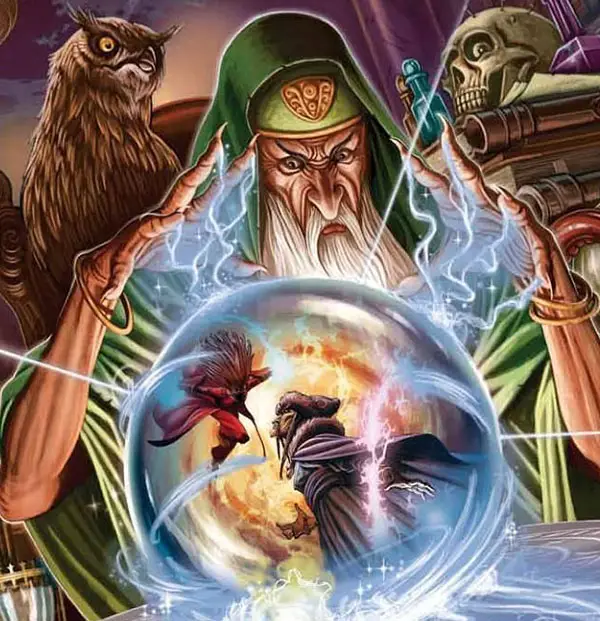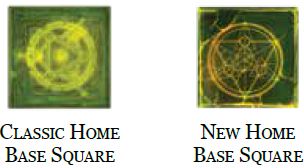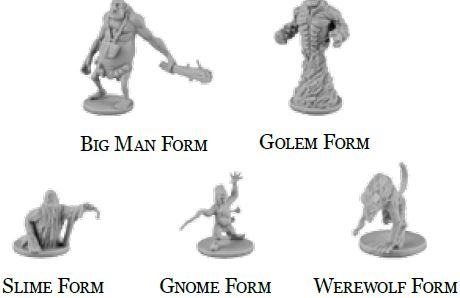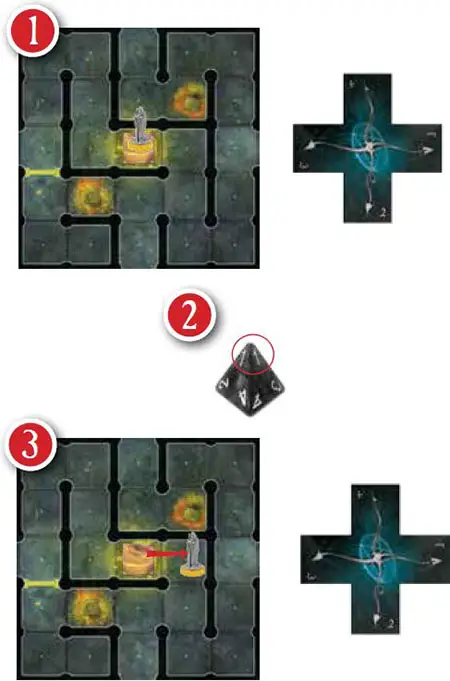
This section address rules not previously explained.
Hat Tokens
Hat tokens are placed on cards to identify which wizard is targeted by those spells. For example, if a permanent or temporary spell targets the red wizard, place a red hat token on that spell's card.
Players also place hat tokens on object tokens on the board when multiple objects of the same type (two rosebushes, for example) are on the board. The hat tokens indicate which player's spell created the duplicate.
If a player places an object on the board that is the same as an object another player already placed on the board, he places one of his hat tokens on his object.
This indicates that he is the player maintaining the duplicate object. If the original object is later removed from the board so that the object with the hat token is the only one of its kind on the board, the player returns his hat token to his supply as it is no longer needed to indicate ownership of the object.
Example: The blue player creates a rosebush and places the rosebush token on the game board. Since it is the only rosebush in play, the blue player is not required to place a hat token on it. It clearly belongs to the blue player.
The green player later places a rosebush on the game board while the first rosebush is still in play. The green player places one of his hat tokens on his rosebush token to mark the rosebush as his.
The blue player's rosebush still doesn't need a hat token. Similarly, if the blue player had created the second rosebush instead of the green player, the bush would not need a token.
A Stunned Wizard
A stunned wizard may either move or attack on his turn, but not both. A wizard who chooses to move cannot make an attack that turn.
A wizard who chooses to attack cannot voluntarily leave the square he's in that turn for any reason (including by casting a spell that would move him out of that square). A stunned wizard may take other actions normally, including picking up objects and casting neutral spells.
Example: The yellow wizard is stunned. He casts "Fireball" on the green wizard. He cannot then cast "Teleport" to move out of his square.

Canceling, Reducing, and Evading Spells
During the chaos of a wizard duel, spells and counter spells fly fast and furious. During these rapid exchanges, a spell can be canceled, reduced, or evaded.
A spell that is canceled while being cast is simply discarded without effect (along with any energy cards played with it). It is as if the spell was never cast in the first place, although a canceled attack still counts as that player's attack for the turn.
Example: The blue wizard casts "Fireball" at the green wizard. "Fireball" would normally cause 5 damage to the green wizard, but he casts "Full Shield", which cancels the "Fireball" entirely.
The blue wizard discards the "Fireball" card without effect, and the blue wizard cannot make another attack this turn.
Spells may be reduced in either damage or duration as specified by the counter spell being cast. A reduced spell still takes effect, just in a diminished form.
Example: The blue wizard casts "Fireball" at the green wizard. "Fireball" would normally cause 5 damage to the green wizard, but he casts "Shield" (with no additional energy), which reduces "Fireball's" damage by 2.
The green wizard suffers 3 damage, and the blue wizard cannot make another attack this turn.
If a spell's damage is reduced to "0", then no damage is suffered . Therefore, secondary effects (such as "Boomstone" exploding) do not occur.
If a spell's duration is reduced to "0", then the spell is canceled.
A spell that is evaded fails to hit its target. The spell is still cast, but it doesn't affect the wizard who evaded it.
Sometimes a wizard must roll a die to determine whether he successfully evades a spell.
Note: Some spells specify that they cannot be evaded.
Example: The blue wizard casts "Fireball" at the green wizard. The green wizard casts "Gnome Form" on himself, giving him a chance to evade the attack on a die roll of "1" or "2".
The green player rolls a "2", so he successfully evades the attack and suffers no damage. (If the green wizard had rolled a "3" or "4", he would have suffered full damage). The blue wizard cannot make another attack this turn.
Players are free to play as many counter spells in response to the same spell as they wish (for example, two "Shield" spells). A player may wait for his first counter spell to resolve before playing another one.
Life, Damage, and Dying
Each player's wizard starts the game with "15" life, and a wizard's life can never exceed "20". Any life gained in excess of "20" is wasted.
A player whose wizard is reduced to "0" or less life is eliminated from the game and cannot win. Remove the wizard figure from the game board. The wizard drops all items he was carrying in the square where he died and discards all his maintained spells. His treasure markers remain in play.
A wizard who dies while performing an action that would normally win the game is considered to have died prior to winning the game, and that wizard's player is eliminated from the game instead.
If another player reduces a wizard to "0" or less life as a direct result of an attack, the attacking player immediately scores 1 victory point and places the dead wizard's figure in his play area.
He then takes any cards the dead wizard's player had left in his hand (not including carried items and maintained spells) and adds them to his own hand.
If taking these cards causes the player to exceed his maximum hand size, he must immediately discard excess cards from his hand until he reaches his maximum hand size.
If a wizard is killed indirectly, such as by damage from a wall being destroyed in his proximity or from moving through a "Wall of Fire", then the cards remaining in his player's hand are discarded and no one receives a victory point for killing his wizard.
Home Base Squares
Each wizard has one home base square on his sector board, indicated by a runic circle in his color. Enemy treasures dropped in a wizard's home base square each count as 1 victory point as long as they remain there.
Objects (such as stone blocks, thornbushes, etc). cannot be created in a wizard's home base square. Walls however may be created along the edges of a wizard's home base square. The appearance of a home base square varies depending on whether it is on the classic side or the new side of a sector board, as seen below:

Random Directions
Occasionally, a wizard may be asked to determine a random direction. When this happens, place the random direction overlay adjacent to the game board (in any orientation) with one edge flat against the game board as shown.
Then roll the die and use the direction indicated by the die.
Transformed Wizards
When a wizard casts a spell that transforms him, the player removes his wizard figure from the colored plastic base and places the transformed figure that corresponds to the spell into the base.
When the transformation ends, the player replaces the transformed figure with his wizard figure. The possible transformed figures are as follows:

Determining a Random Direction

1 The yellow wizard wants to move out of a dust cloud, but the dust cloud forces the wizard to move in a random direction. To do so, the player places the random movement overlay and rolls the die.
2 He rolls a "1".
3 he moves the yellow wizard in the corresponding direction (to the right).
Continue Reading


